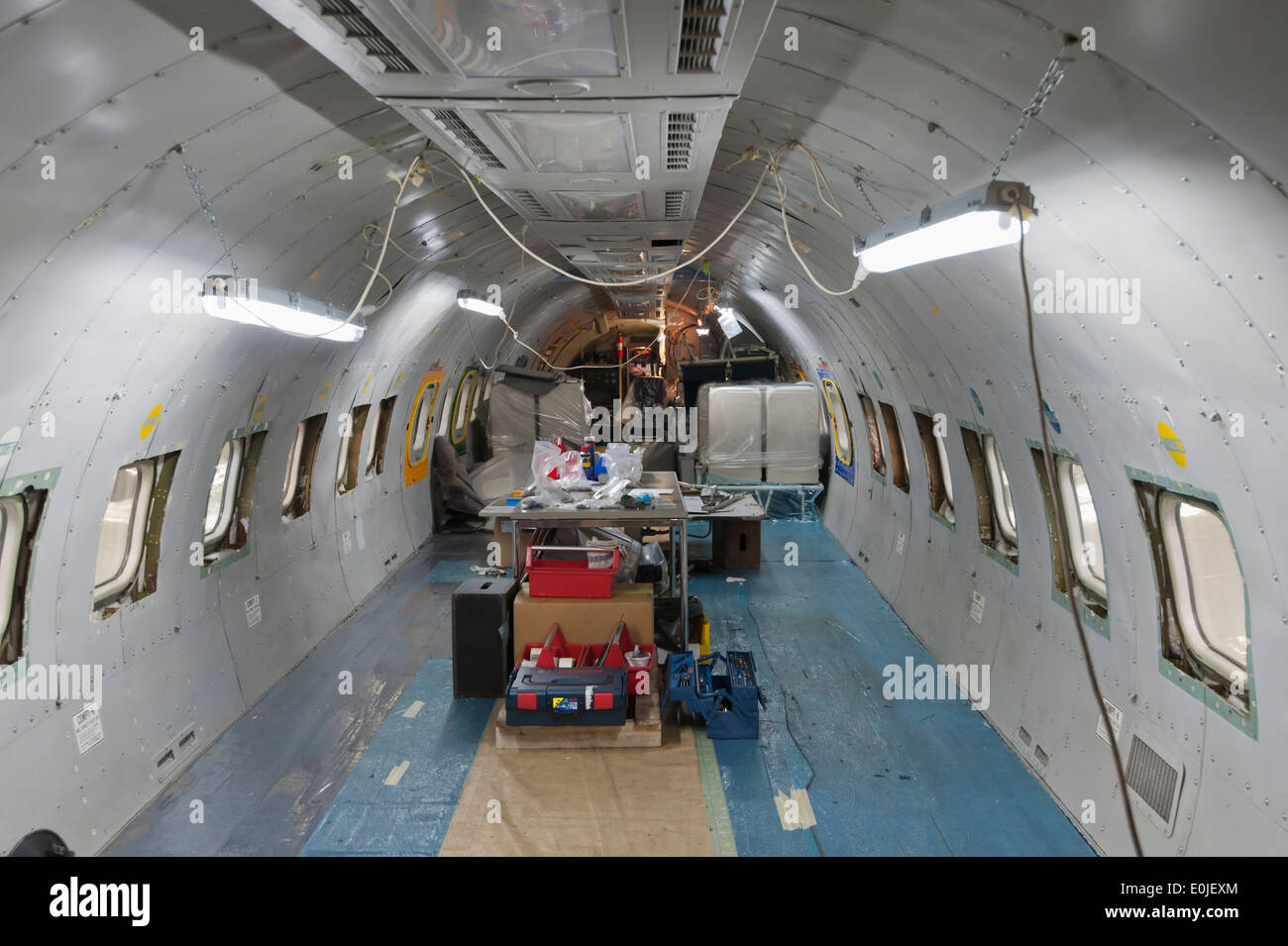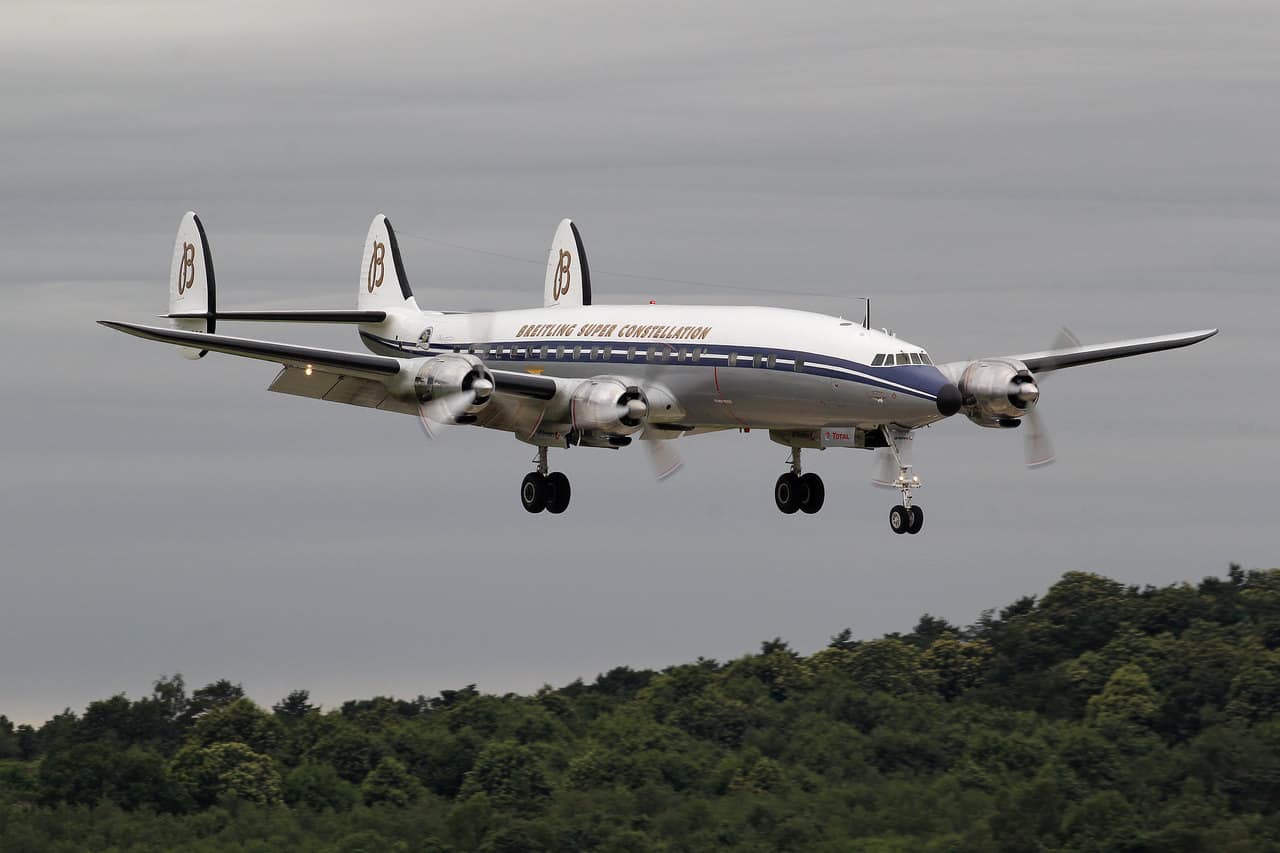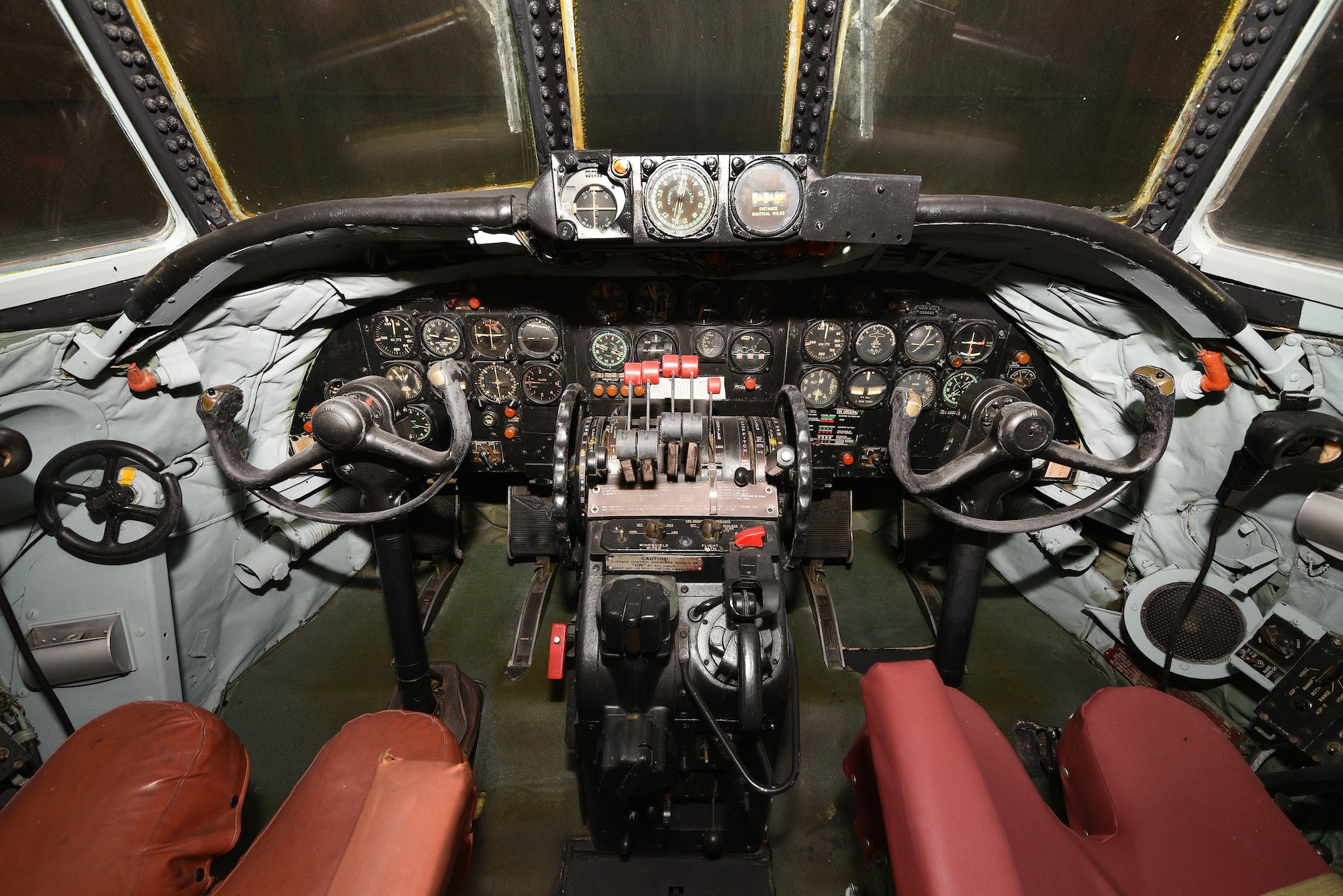Super Constellation Aircraft - There it was expected to run a twice-weekly fresh tuna airlift service to Nagoya, Japan. However, this was not to be. The cargo capacity proved to be inadequate, a problem compounded by the non-availability of the right type of fuel at the Nagoya airport.
The military liked the design so much that they took over the production of the plane in 1942 and used it for transporting troops and supplies from the United States to Europe. Now designated as the C-69, Hughes publicized TWA's new airliner by flying from California to Washington DC in a transcontinental record-breaking six hours and 57 minutes.
Super Constellation Aircraft

During the flight, the Constellation's average speed was 331 mph. When the war ended, TWA bought as many C-69s as it could from the government, putting the plane into commercial service in February 1946. Although President Franklin D. Roosevelt was the first president to fly while in office in 1945 on the C-54 "Sacred Cow," President Dwight D. Eisenhower was the first president to fly on an aircraft using the Air Force One call sign.
During Wwii All Constellations Built Went To The Military
This aircraft was the VC-121A “Columbine II.” Besides being the last long-haul piston-engined airliner to dominate the skies before the advent of the jet era of travel, the Lockheed Super Constellation has a special place in the history of Australia's flag carrier airline, Qantas, and, by extension, of
Australian aviation. The first official flight test for a Constellation, sheathed in olive green paint and redesignated C-69, came early the next year. It was a plane equally beautiful in form as well as function. First flight went so well that five more flights were performed the first day.
Hughes went about publicizing the Constellation the best way he knew how: by breaking a transcontinental speed record on a Burbank to Washington, D.C., flight in April 1944. The Connie averaged 331 mph, flying nonstop in six hours, 57 minutes, and 51 seconds
on this flight. After setting the record, that aircraft was returned to the military and during service testing at Wright Field, Ohio, Orville Wright, who had made the first powered flight, made his last flight, serving as copilot on a test run.
The Customer Wanted A Plane That Could Fly Non-Stop Across The Usa
The 1049G "Super G" was the most successful version of the Super Constellations and one of the last great piston-engine airliners. For long range operations, the Super G could be fitted with extra wingtip tanks, increasing the fuel capacity by two-thirds more than the original Connie models.
The first flight of the G-model Constellation was on December 7, 1954, and it was introduced to commercial service by Northwest Airlines on July 1, 1955. The Super G was a popular choice among the airlines, with 42 being flown by domestic carriers

and 59 by foreign airlines. However, soon after the plane's introduction, it became clear that jet airliners were the future. President Eisenhower was a big fan of the Connie, and his personal presidential plane, the only VC-121E built, was the first to bear the now-recognized moniker "Air Force One" when the president was onboard.
All told, the U.S. military bought nearly 40 percent of all the Constellations ever manufactured, using them over nearly three decades, with aircraft serving well into the 1970s. The military adapted the plane for its further use in the 1950s and 60s by modifying it for radar and using it as an aerial extension of the Distant Early Warning (DEW) Line, and in aiding in the rescue of downed aircraft in Southeast Asia.
The Lockheed L- Super Constellation
In addition, the Military Air Transport Service (MATS) used a fleet of 70 C-121s from 1948 to 1967. Flew Connies as Flight Engineer at Flying Tigers 1965-67. Remember feeding popcorn to a baby elephant on his way to a new home.
Listening to a full grown Bengal Tiger howling behind that canvas fire curtain. The elephant took one look at the Newark ramp and threw up. Such was life in the air cargo business. Journalist - Mark is an experienced travel journalist having published work in the industry for more than seven years.
His enthusiasm for aviation news and wealth of experience lends itself to some excellent insight, with his work cited in Forbes among other publications. Based in Alicante, Spain. They left the Super Connie ready for Quick Strip Dustless Blasting Services, a specialized team from Cairns that would strip and repaint the aircraft by sections.
To do this, they built a structure to enclose the disassembled aircraft. There was a bar in the rear of the plane as you entered the fuselage door from the main staircase with a small parquet dance floor in front of it.
Some of the seats were reversed with tables placed between them to seat four together. The windows had aerial views of famous landmarks that were backlit with fluorescent lighting for night viewing. Dinners were typically brought up from the kitchen in the main restaurant below, but there was a small steam table in the front of the plane from which we could serve prepared foods like Prime Rib and vegetables.
Over the coming years, the plane that Lockheed called the "Constellation," or "Connie" for short, would dominate global travel for decades. The Constellation would become the epitome of grace in a propeller-powered plane featuring a distinctive triple tail and a dolphin-like fuselage.

Flown by airlines worldwide and the United States military, the Constellation was a revolutionary passenger and cargo aircraft. In the years to come, the plane would be named the Constellation—Connie for short—and be flown by airlines around the world, as well as the U.S.
military over the ensuing three decades. Eventually, it would be remembered as an enduring symbol, the epitome of grace in propeller-driven aircraft. But at that moment in 1939 in Los Angeles, the Lockheed Corporation was focused on winning over one customer and one customer only.
His name was Howard Hughes. Thank you for restoring this great airplane! I joined the NJANG in 1966 and was a dock mechanic on these airplanes. I wanted to fly, so was given an opportunity to be an Engineer on the 121, however, during my training we were assigned C-141s, which were never received,, then we were assigned C-7s, which I believe you also still
have one there. Finally about 1980 assigned KC-135A, which were converted to KC135E and finally, KC-135R, after my time. In 1996, Amoco Corporation purchased a lot in Penndel, Pennsylvania, which contained a restaurant topped by a Lockheed C-121 Constellation aircraft.
Realizing the historical significance of the plane, Amoco offered the plane to the Air Mobility Command Museum. It was transported to the museum in December of 1997 and is now completely restored. (I was a young mother of a toddler son, so the AF assigned a young airman to help me. It was my first “grand adventure” and my son adored his cheerful new friend. An officer gave me a lei in Hawaii & the pilot
allowed me to visit the cockpit after dark. A crew member let me wedge in between the garbage collector & window with my movie camera to film our landing on Kwajalein Island!) By 1951, the much-beloved Model 1049 Super Constellation was unveiled, boasting unheard-of refinements, such as air conditioning, reclining seats, and extra lavatories.
It was a plane ahead of its time, at least twice as fuel efficient as the industry's first jets and as efficient as many of today's modern aircraft. The elegant Lockheed Constellation was born from requirements put forth in 1939 by Howard Hughes for Transcontinental and Western Air (TWA) Lines.
The first version, Model 49, flew in January 1943 with Eddie Allen (on loan from Boeing) at the controls. The war interrupted TWA's plans, and the airplane was pressed into military transport service as the C-69.

The "Connie" was improved after the war with greater fuel capacity and payload and more powerful engines. Lockheed introduced the further-enlarged 1049 Super Constellation in 1950, part of an epic battle with its Southern California rival, Douglas.
The Museum's Constellation was delivered to Trans-Canada Airlines in 1954 as a 1049C and was later converted to the 1049G standard. TCA's Connies were replaced by Douglas DC-8s by 1962. After a career flying passenger and later cargo with World Wide Airways, the aircraft retired from flying in 1965. It sat in derelict condition for many years in different locations in Quebec and Ontario, Canada
. It was partially restored and made into a museum during this period. Later, it was converted into a hotel cocktail lounge and lunch delicatessen at the Toronto airport during 1996-2002. However, during the meeting in 1939, the executives at Lockheed were only interested in securing an order from one man.
The man in question was American business magnate Howard Hughes. Having just bought a majority stake in Trans World Airlines (TWA), Hughes wanted the Constellation to be his secret weapon. By having a pressurized airliner that could fly non-stop from coast to coast, Hughes was confident of TWA dominating the marketplace.
When ordering the aircraft, Hughes made Lockheed agree that they would not sell the plane to any competing airline until TWA had received a minimum of 35 planes. The 1049G "Super G" was the most successful version of the Super Constellations and one of the last great piston-engine airliners.
For long range operations, the Super G could be fitted with extra wingtip tanks, increasing the fuel capacity by two-thirds more than the original Connie models. The first flight of the G-model Constellation was on December 7, 1954, and it was introduced to commercial service by Northwest Airlines on July 1, 1955. The Super G was a popular choice among the airlines, with 42 being flown by domestic carriers
and 59 by foreign airlines. However, soon after the plane's introduction, it became clear that jet airliners were the future. Growing up as a 'USAF BRAT' in the '60s & '70s afforded our family a great deal of travel around the world.
The 'SUPER CONNIE' holds a special place in my heart when @ age 5, we were about to REUNITE with 'Daddy' on Kadena AB, Okinawa after he flew ahead about a month to arrange for housing.
We departed from Travis AFB on a MATS C-121 & arrived ALL OF 2 DAYS LATER with refueling stops in Honolulu & on Wake Island. A grinning Dad was standing on the ramp @ the bottom of the stairs as we deplaned!
The customer's request had been ambitious. He hoped to hire Lockheed to design a revolutionary aircraft capable of comfortably shuttling 20 passengers and 6,000 pounds of cargo across the United States, offering commercial aviation's first coast-to-coast, non-stop service.
Layer upon layer of silt had buried the aircraft's undercarriage. It had to be dug out and new wheels brought in from the US for the aircraft to be rolled to firmer ground by the Qantas Engineering Aircraft Recovery Team.
This, however, all changed two years later, in 1939, when a man with bottomless pockets requested a meeting with Lockheed President Robert Gross and Chief Engineer Hall Hibbard. The man told the Lockheed executives that he wanted a fleet of planes that could fly non-stop across the United States.
At the time, Lockheed also wanted to build a large aircraft that would convince people to fly rather than take the train. In 1962 my Dad was Transferred to Japan and we flew from Travis AFB to Japan it took 36 hrs and we loved it I was in Jr High at the time.
The next time I flew in it was 1968 to Viet Nam. I was a navigator on the 121 in 1962-3, flying from Navy Moffet Field in Calif. to Travis where we picked up our passengers to the Far East, stopping for fuel at Hickam AFB, Wake, Guam, Midway.
In 1963 we converted to the C-130. In the C-121 we never flew above 12,000′. That was tough for us navs because we were sometimes in the clouds which made the sexton useless. No such problem in the C-130s–flew above the clouds mostly.
Jack Williams The C-121A was the military variation of the commercial Model 749 Constellation. Between 1948 and 1955 the USAF ordered 150 C-121As for use as cargo/passenger carriers, executive transports, and airborne early warning aircraft. As a troop carrier they could carry a maximum of 44 passengers.

While these are all significant improvements over the original Constellation, introducing air-conditioning to an aircraft was the most considerable progress. The maiden flight of the production L-1049 took place on July 14, 1951, entering service with Eastern Air Lines in December 1951 on flights between Miami and New York.
In 1953 Netherlands national flag carrier KLM put an L-1049C on its Amsterdam to New York route and later used an L-1049G for flights from Amsterdam to Tokyo and Sydney. Its area of distinction, however, was clearly airborne command and control and early warning.
During the Vietnam War, Connies were flown in elliptical orbit near enemy territory to collect and transmit information on air activity. Constellations were also the first planes to carry rotating radomes, saucer-shaped domes used to protect radar antennas, a technology that is still in use with modern aircraft controlling the skies over the Middle East and with US Customs and Border Protection P-3s running drugs
interception missions in the Caribbean today. While only 13 Constellations were built during World War II—Lockheed would be asked, instead, to focus on the P-38—the Army, Air Force, and Navy had recognized the plane's versatility. By 1948, the Navy was calling in orders for Connies to act as long-range patrol aircraft, nicknamed Po-Boys from the PO-1 designation then in use.
In time, Constellations would be used for everything from rescue missions and VIP transports to airborne early warning missions and the mapping of the earth's magnetic field. It was then acquired by Northern Peninsula Fisheries. This firm planned to use the aircraft during the Alaskan fish-hauling season.
However, issues with its certification for civilian use meant it remained idle at Arlington Municipal Airport, in Washington state, until 1987. In 1939, the top brass of the Lockheed Corporation—president Robert Gross, chief engineer Hall Hibbard, and chief research engineer Kelly Johnson—scheduled a key meeting with a VIP, a man with deep pockets who had recently shown an interest in buying not just
one or a handful of new planes but a fleet of them. In 1973 it was flown to the Military Aircraft Storage and Disposition Center (MASDC) at Davis Monthan Air Force Base, Tucson, Arizona. But it wasn't until 1981 that the Department of Defense put it up for sale.
lockheed super constellation 1962, super constellation aircraft for sale, l 1049 super constellation, super constellation engines, lockheed l 1049 super constellation, lockheed super connie, lockheed super constellation, super g constellation
